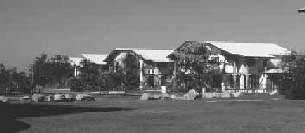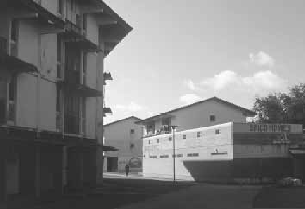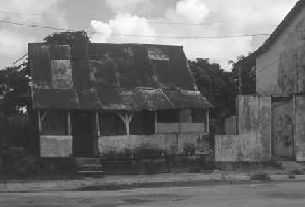THE CITY OF SPACE:
A TOUR OF KOUROU'S NEW TOWN
But what was the urban space created around the space center? How does the physical layout of Kourou fit with its descriptions? In the enthusiastic memoirs of a former prefect, a political figure strongly in favor of closer ties with France, the early story of space can be summarized as follows:
From a modest village of some hundred residents, Kourou has become a stylish city of five thousand souls, with a supermarket, a hospital, … two great hotels, a magnificent pool, where the Guyanais come to pass the weekend with their families or elegant company. Evidently researchers of CNES have the tendency to live in isolation, sticking with each other. But nevertheless they are consumers of remarkable purchasing power who affect the Guyanais market, and a number of new shops have been created in Cayenne to satisfy them. All Guyanais youth devoted to physics, mathematics, data-processing, and mechanics have been recruited by CNES. True, they are not numerous; most orient themselves toward letters, law, or medicine. But CNES has offered them other opportunities in their own department, and that they appreciate greatly. For jobs of lesser scale, a training center devoted to the various techniques of space has been opened in Kourou. Thus, as was easy to anticipate, the creation of CNES has been particularly beneficial to French Guiana. That has not, however, prevented the political situation from evolving in a different direction than it was logically permitted to hope.[36]
But such an outline allows no fine resolution; it provides only the most general of maps and vaguest of reservations (“evolving in a different direction than it was logically permitted to hope”). The French social scientist Marie-José Jolivet presents us with a more detailed, biting tour of the newly constructed Kourou, circa 1971. In Kourou, she suggests, “socio-professional hierarchy is found to be exactly inscribed on the ground.” This thesis, simultaneously descriptive and analytic, merits extended attention.[37]
Beginning the inventory by the Pointe des Roches, the granite promontory situated at the mouth of the river where one can still see “Dreyfus' Tower,”
- The “des Roches” quarter—Clearly at a distance from the rest of the town, this is the finest residential neighborhood. One finds there first of all a hundred-room luxury hotel, with bar, restaurant, and pool. Just beside it is a private club. Further on, by the sea, the two villas of the respective directors of CSG and ELDO, as well as six other houses reserved for their immediate deputies.
- The “executive” quarter—Further west, but always close to the sea, come then some one hundred identical villas set in rows, which principally house engineers and administrative personnel of the base.
- The city center—Italianate in style, its apartment blocks frame an internal plaza of sorts, prohibited to automobiles, adorned with flower beds and ornamental pools, and surrounded by arcades that open into shops. It is there that we find the supermarket … and the industrial bakery …. The residential buildings have two or three floors and include more than two hundred apartments, occupied by technicians, staff, and shopkeepers.
- The “Calypso” quarter—This consists of a group of three hundred prefabricated chalets, situated on the eastern side of the central plaza. These were the first lodgings built, originally to house the people who came for the installation of CSG, and later turned over to personnel of the construction companies. In 1971 their occupancy is more varied but still for the most part Metropolitan.
- The lower-income district—These low-rise, multiple-family dwellings stretch to the south and westward of the city center. In some 250 apartments Metropolitans and Creoles mix, mostly semiskilled workers, some teachers, and young civil service volunteers.
- The very low income district—This consists of high-rise blocks, built last at the entrance to town. This quarter includes two hundred apartments for the Creole workforce.
Such is the town of Kourou proper. Differentiation, one sees, comprises the primary element of its conception. But this phenomenon does not stop there: units forming the suburbs of the city only emphasize it. These are:
- The “Cité Stade,” or housing for the relocated—At the edge of town, this district was built to shelter those whose land was expropriated by the base. The structures are low-rise concrete blocks, the most economic possible, comprising sixty or so apartments that, in 1971, have already acquired a dilapidated look.
- The Maroon village—Well hidden behind the stadium and the empty lots that separate the housing for the relocated from the old town center, this village was built around a water standpipe by Saramakas and Bonis, with the help of recycled materials (old planks, beams) that were “generously” provided for them. In fact there are two distinct sections: Saramakas and
― 137 ―Bonis [Aluku] do not mix. As a whole it is composed of rows of rudimentary shacks that, far from resembling the charming villages along the Maroni, form nothing but a sad shantytown, despite the undeniable efforts by its residents to make the place more attractive.
- The Indian village—The Galibi [Kaliña] have changed location several times. Their villages were first formed of traditional huts: “carbets,” entirely open [wood and] dried-leaf shelters. In 1971, they have just settled in a new village built in accordance with their wishes. This last is situated at the entrance to the town but near the edge of the sea and far back from the road. It is comprised of enclosed huts in Creole style, forms now preferred by those concerned themselves, who are weary of being the object (private life included) of tourist curiosity.
- The “Old Town”—Starting from the dock of the old ferryboat, the old town stretches along a main street perpendicular to the river. Formerly the national road, this street has become a cul-de-sac since the construction of the bridge spanning the Kourou River some kilometers upstream and the subsequent displacement of the road. Some houses in concrete have appeared here and there. But as an ensemble, with its old wooden houses, its quaint town hall, and its little church, the old town preserves the flavor of a rural Guyanese Creole settlement.
Having provided us with the elements, Jolivet then sums up the resulting social constellation:
For the Boni or Saramaka laborer: salvaged boards and a well-camouflaged shantytown (the landscape must not be disfigured!). For the relocated cultivator: cramped accommodations in a reserved housing development. For the Creole worker: a low-income apartment in a public housing project located at the entry of the city. For the skilled worker: an apartment in a standard public housing complex at the edge of the town's center, the only place where it is imagined that Creoles and White could mix. And then, the White town, with its hierarchical gradations also scrupulously respected. Such is the conception of the new city of Kourou! Can one have dreamed up a more vivid demonstration of the expertise of Whites to orchestrate the countless hierarchical encounters that allow them to maintain the ideological bases of their domination?
While Jolivet's tour is hardly dispassionate—relentless anger pressing between every line—it remains careful and spatially exact. The built environment, entrenched as is, lends empirical clarity to her claims: people in buildings are easy to locate, easy to count. Both the power and the weakness of a fortress, after all, lie in its fixed position and visibility.[38] The new town of Kourou, so exposed in its French Guiana setting, cannot hide the starkness of its form. In replacing the vernacular

Figure 11. Villas, Kourou, 1993

Figure 12. Apartments, Kourou, 1993

Figure 13. Shack, Kourou, 1993
What we have in Kourou is a future archaeologist's dream. Structure speaks; society lies written on the ground. In one forgotten corner between river and the sea, a human epic is quickly rewritten, from first world to third world. Kourou, then, is a new colony (its imported elements “up to date”), but one that reproduces an old colonialism in its racial divides reinforced by social class. Taken more broadly, Jolivet's point carries further still. Social class here is reinforced by educational certification and technical expertise. The discrepancies of capitalism, wide verandah to tiny room, meet the gray uniformity of social welfare, row upon row of universal shelters; parts of France's space city
At the moment of Jolivet's survey, Kourou was also entering a period of crisis, anticipated by the failure of the Europa program. Yet even as the space center lapses into inactivity and the buildings it inspired begin to decay (their futuristic touches aging especially badly), the structure of the urban layout remains. The requisite elements of a launch program are still in place, as is the general shape of the town next to it. Prophetically, Jolivet concludes her spatial review by wondering if the hierarchical structure of Kourou would not necessarily reproduce similar social patterns should the program expand again.[39] No matter what might come after, the foundations of the future had been laid.